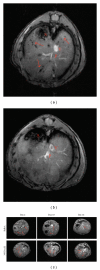Molecular imaging: a promising tool to monitor islet transplantation
- PMID: 22013504
- PMCID: PMC3195545
- DOI: 10.1155/2011/202915
Molecular imaging: a promising tool to monitor islet transplantation
Abstract
Replacement of insulin production by pancreatic islet transplantation has great potential as a therapy for type 1 diabetes mellitus. At present, the lack of an effective approach to islet grafts assessment limits the success of this treatment. The development of molecular imaging techniques has the potential to fulfill the goal of real-time noninvasive monitoring of the functional status and viability of the islet grafts. We review the application of a variety of imaging modalities for detecting endogenous and transplanted beta-cell mass. The review also explores the various molecular imaging strategies for assessing islet delivery, the metabolic effects on the islet grafts as well as detection of immunorejection. Here, we highlight the use of combined imaging and therapeutic interventions in islet transplantation and the in vivo monitoring of stem cells differentiation into insulin-producing cells.
Figures



Similar articles
-
Current Progress and Perspective: Clinical Imaging of Islet Transplantation.Life (Basel). 2020 Sep 19;10(9):213. doi: 10.3390/life10090213. Life (Basel). 2020. PMID: 32961769 Free PMC article. Review.
-
The impact of oxidative stress on islet transplantation and monitoring the graft survival by non-invasive imaging.Curr Med Chem. 2013;20(9):1127-46. doi: 10.2174/0929867311320090003. Curr Med Chem. 2013. PMID: 23317098 Review.
-
In Vivo Magnetic Resonance Imaging of Small Interfering RNA Nanodelivery to Pancreatic Islets.Methods Mol Biol. 2016;1372:25-36. doi: 10.1007/978-1-4939-3148-4_2. Methods Mol Biol. 2016. PMID: 26530912
-
Molecular imaging of pancreatic islet transplantation.Exp Clin Endocrinol Diabetes. 2014 Feb;122(2):79-86. doi: 10.1055/s-0033-1363232. Epub 2014 Feb 19. Exp Clin Endocrinol Diabetes. 2014. PMID: 24554507 Review.
-
MRI as a tool to monitor islet transplantation.Nat Rev Endocrinol. 2009 Aug;5(8):444-52. doi: 10.1038/nrendo.2009.130. Epub 2009 Jun 23. Nat Rev Endocrinol. 2009. PMID: 19546863 Review.
Cited by
-
Nanotechnology in Kidney and Islet Transplantation: An Ongoing, Promising Field.Front Immunol. 2022 Apr 8;13:846032. doi: 10.3389/fimmu.2022.846032. eCollection 2022. Front Immunol. 2022. PMID: 35464482 Free PMC article. Review.
-
Monitoring of Allogeneic Islet Grafts in Nonhuman Primates Using MRI.Transplantation. 2015 Aug;99(8):1574-81. doi: 10.1097/TP.0000000000000682. Transplantation. 2015. PMID: 25806407 Free PMC article.
-
Theranostic magnetic resonance imaging of type 1 diabetes and pancreatic islet transplantation.Quant Imaging Med Surg. 2012 Sep;2(3):151-62. doi: 10.3978/j.issn.2223-4292.2012.08.04. Quant Imaging Med Surg. 2012. PMID: 23256077 Free PMC article.
-
Quantifying β-cells in health and disease: the past, the present, and the need.Diabetes Care. 2013 Jan;36(1):4-5. doi: 10.2337/dc12-1526. Diabetes Care. 2013. PMID: 23264284 Free PMC article. No abstract available.
-
Early-Phase Luciferase Signals of Islet Grafts Predicts Successful Subcutaneous Site Transplantation in Rats.Mol Imaging Biol. 2021 Apr;23(2):173-179. doi: 10.1007/s11307-020-01560-2. Epub 2020 Nov 2. Mol Imaging Biol. 2021. PMID: 33140260 Free PMC article.
References
-
- Group DP. Incidence and trends of childhood type 1 diabetes worldwide 1990–1999. Diabetic Medicine. 2006;23(8):857–866. - PubMed
-
- Azzi J, Geara AS, El-Sayegh S, Abdi R. Immunological aspects of pancreatic islet cell transplantation. Expert Review of Clinical Immunology. 2010;6(1):111–124. - PubMed
-
- Kelly WD, Lillehei RC, Merkel FK, Idezuki Y, Goetz FG. Allotransplantation of the pancreas and duodenum along with the kidney in diabetic nephropathy. Surgery. 1967;61(6):827–837. - PubMed
-
- Fioretto P, Steffes MW, Sutherland DER, Goetz FC, Mauer M. Reversal of lesions of diabetic nephropathy after pancreas transplantation. The New England Journal of Medicine. 1998;339(2):69–75. - PubMed
-
- Downing R. Historical review of pancreatic islet transplantation. World Journal of Surgery. 1984;8(2):137–142. - PubMed
Grants and funding
LinkOut - more resources
Full Text Sources

